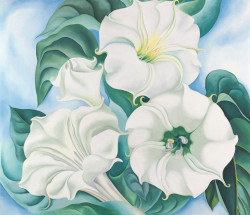O'Keeffe was immensely fond of jimson weed, a species of Datura . She ignored its seeds' toxicity, allowing it to flourish around the patio of her home in the New Mexican desert. [2] She paid tribute to the bloom in this painting, originally entitled Miracle Flower. Jimson Weed was commissioned by cosmetics magnate Elizabeth Arden for the new Gymnasium Moderne of her Fifth Avenue Salon in New York City. Placed in the exercise room, the unfurling blossoms were meant to encourage clients in their stretches. Arden paid $10,000 for the largest floral composition O'Keeffe would ever create. [3]
This page is based on this
Wikipedia article Text is available under the
CC BY-SA 4.0 license; additional terms may apply.
Images, videos and audio are available under their respective licenses.
